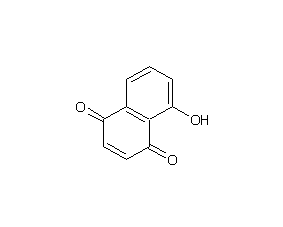
Structural formula
| Business number | 0527 |
|---|---|
| Molecular formula | C10H6O3 |
| Molecular weight | 174.16 |
| label |
5-hydroxy-1,4-naphthoquinone, 5-hydroxy-1,4-naphthoquinone, Juglone, 1,4-Naphthalenedione, 5-hydroxy-, 5-Hydroxy-1,4-naphthoquinone, 5-Hydroxy-1,4-naphthalenedione, Juglone |
Numbering system
CAS number:481-39-0
MDL number:MFCD00001684
EINECS number:207-567-5
RTECS number:QJ5775000
BRN number:1909764
PubChem ID:None
Physical property data
1. Properties: yellow needle-like crystals
2. Density (g/m3, 25/4℃): Undetermined
3 . Relative vapor density (g/cm3, air=1): Undetermined
4. Melting point (ºC): 161-163
5. Boiling point (ºC, normal pressure): 250
6. Boiling point (ºC, 5.2kPa): Undetermined
7. Refractive index: Undetermined
8 . Flash point (ºC): Not determined
9. Specific rotation (º): Undetermined
10. Autoignition point or ignition temperature (ºC): Not determined
p>
11. Vapor pressure (kPa, 25ºC): Undetermined
12. Saturated vapor pressure (kPa, 60ºC): Undetermined
13. Heat of combustion (KJ /mol): Undetermined
14. Critical temperature (ºC): Undetermined
15. Critical pressure (KPa): Undetermined
16. Oil and water Log value of the (octanol/water) partition coefficient: Undetermined
17. Explosion upper limit (%, V/V): Undetermined
18. Explosion lower limit (%, V /V): Undetermined
19. Solubility: Dissolved in hot water
Toxicological data
1. Acute toxicity: Rat oral LD50: 112mg/kg, no detailed description except lethal dose;
Mouse oral LD50: 2500ug/kg, behavior – lethargy (ordinary depressive activity) );
Mouse intraperitoneal LD50: 25 mg/kg, no detailed instructions except the lethal dose;
Dog intravenous LD50: 10 mg/kg, no detailed instructions except the lethal dose ;
2. Oncogenicity data: Mouse transdermal TDLo: 394 mg/kg/53W-I, tumor-tumor RTECS standard, skin and appendages-tumor
3. Mutagenicity data: Microorganism TEST system mutations: Bacteria – Salmonella typhimurium: 30 ug/plate;
Loss and non-disjunction of sex chromosomes: OralTEST system: Insects – Drosophila: 10 pph;
Mutation testing system – not other specifiedTEST systems��Rodent-mouse ascites: 10 mg/kg.
Ecological data
General remarks
Water hazard level 1 (German regulations) (self-assessment via list) This substance is slightly hazardous to water.
Do not allow undiluted or large amounts of product to come into contact with groundwater, waterways or sewage systems.
Do not discharge materials into the surrounding environment without government permission.
Molecular structure data
1. Molar refractive index: 44.78
2. Molar volume (cm3/mol): 120.9
3. Isotonic specific volume (90.2K ): 345.7
4. Surface tension (dyne/cm): 66.7
5. Polarizability (10-24cm3): 17.75
Compute chemical data
1. Reference value for hydrophobic parameter calculation (XlogP): None
2. Number of hydrogen bond donors: 1
3. Number of hydrogen bond acceptors: 3
4. Number of rotatable chemical bonds: 0
5. Number of tautomers: 5
6. Topological molecule polar surface area 54.4
7. Number of heavy atoms: 13
8. Surface charge: 0
9. Complexity: 280
10. Number of isotope atoms: 0
11. Determine the number of atomic stereocenters: 0
12. Uncertain number of atomic stereocenters: 0
13. Determine the number of chemical bond stereocenters: 0
14. Number of uncertain chemical bond stereocenters: 0
15. Number of covalent bond units: 1
Properties and stability
Use and store according to specifications, no decomposition will occur, and avoid contact with oxides
Storage method
Seal and store in a ventilated, dry place to avoid contact with other oxides.
Synthesis method
Juglone, as the glycoside of hydrogenated juglone (trihydroxynaphthalene), is found in the immature exocarp (green peel) of Juglans juglans and its congener, Black walnut. It can be isolated from natural substances or chemically synthesized.
Purpose
Juglone has hemostatic and antimicrobial activity and has also been used to treat eczema, psoriasis, and tinea pedis. Used as pH indicator agent.

 微信扫一扫打赏
微信扫一扫打赏

